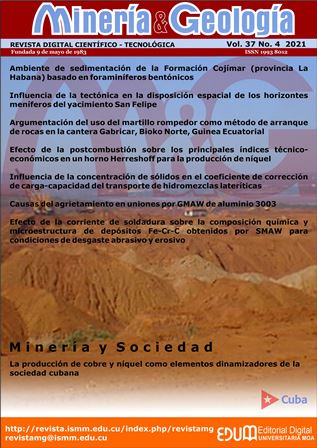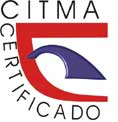Post-combustion effect on the main technical-economic indices in the Herreshoff furnace for nickel production
Keywords:
post-combustion, Herreshoff furnace, nickel reducing roasting, fuel consumption, nickel extraction.Abstract
The main disadvantage of Caron technology for the extraction of nickel from lateritic minerals is the high energy consumption related to the mineral preparation processes in the Herreshoff furnaces prior to the extraction of nickel. This work analyzes the effect of the post-combustion process in the H4 and H6 hearths of the furnace on its technical-economic indices. The tests were carried out in the furnace of the Pilot Plant of the Nickel Research Center (CEDINQ), Moa, Cuba, which reproduces the technology conditions of the Punta Gorda Plant. The experiments were developed in three ways: (1) varying the post-combustion conditions in the H4 and H6 hearths independently, (2) with the use of post-combustion in H4 and H6 varying the temperature in the H6 hearth and (3) without use of post-combustion. The tests were carried out in compliance with the standards established by the Punta Gorda Plant for the quality control of the process. The results obtained indicated that there are appreciable variations in the technical-economic indexes: nickel extraction efficiency, specific fuel oil consumption and, to a lesser extent, in the content of unburned in the furnace outlet gases according to the post-combustion conditions applied. The lowest relative consumption of fuel oil (72%) was reached when post-combustion is applied in H4 and H6 hearths and the temperature in H6 of 750 °C, for which 86.36% of nickel extractable is reached.Downloads
References
Agyei, G., Purón, A. R., & Flores, A. H. 2010: Distribución fraccional de metales y minerales en la laterita de balance del yacimiento Punta Gorda, Moa, Cuba. Minería y Geología, 26(4): 36-52.
Alepuz, H. y Legrá, A. 2005: Informe técnico del proyecto Eficiencia metalúrgica de la Empresa Comandante Ernesto Che Guevara. Centro de Investigaciones del Níquel. Moa, Cuba.
Angulo-Palma, H. J., Terencio-Guevara, P. L., Legrá-Legrá, A., & Videaux-Arcia, L. 2017: Análisis especiales en un horno de reducción de níquel a escala de Planta Piloto. Tecnología Química, 37(3): 484-499.
Barnett, S. 2010: Nickel a key material for innovation in a sustainable future. 2nd Euro Nickel Conference. Informa Pty Ltd, London, UK.
Caron, M. H. 1950: Fundamental and Practical Factors in Ammonia Leaching of Nickel and Cobalt Ores. Journal of Metal, 2: 67-90. DOI: 10.1007/BF0339898
Castellanos-Suárez, J., Castillo, C. R., & García, I. 1986: Elaboración de minerales oxidados de níquel por el esquema carbonato-amoniacal. Minería y Geología. 4(2):77-80.
Chander, S., & Sharma, V. N. 1981: Reduction Roasting/Ammonia Leaching of Nickeliferous Laterites. Hydrometalurgy, 7(4): 315-327. DOI: 10.1016/0304-386X(81)90029-3
Chandra, D., Siemens, R. E., & Ruud, C. O. 1980: Electron-Optical Characterization of Laterites Treated with a Reduction-Roast/ Ammoniacal- Leach System. Journal of Metal, 32(5): 26-33. DOI: 10.1007/BF03354571
Chang-Cardona, A. R. 1999: Una visión sobre las reservas estratégicas de eficiencia metalúrgica en la tecnología carbonato amoniacal. Minería y Geología, 16(1): 76-82.
Chang-Cardona, A. R., Toirac-Suárez, M. M. y Arce-Molina, J. 2006: Modelos multivariables para predecir los extractables de Ni por la composición química de la mena laterítica en la planta Punta Gorda. Minería y Geología, 22(2): 1-29.
Coello-Velázquez, A. L., & Tijonov, O. N. 1996: Regularidad en la molienda de los minerales lateríticos. Minería y Geología 13(3): 57-60.
Legrá, A. y Ramírez, I. M. 2014: Evaluación del comportamiento durante el proceso de tostación reductora y lixiviación de los minerales a procesar por la ECG en el año 2015. Informe técnico. Centro de investigaciones del níquel. Moa, Cuba.
Mendoza, M. R. 2002: Modelado del proceso de postcombustión en un horno de reducción de níquel. Revista de Metalurgia, 38(2): 150-157. DOI: 10.3989/revmetalm.2002.v38.i2.396
Miranda, J. L., Chaviano, L. R., & Miranda, J. R. 2002: Nuevas Interpretaciones químico-mineralógicas de las menas lateríticas y serpentínicas a través del proceso pirometalúrgico en la tecnología carbonato-amoniacal. Revista Cubana de Química, 14(2): 42-50.
Mudd, G. M. 2010: Global trends and environmental issues in nickel mining: Sulfides versus laterites. Ore Geology Reviews, 38(1-2): 9-26. DOI:10.1016/j.oregeorev.2010.05.003
Norgate, T. E., Jahanshahi, S., & Rankin, W. J. 2007: Assessing the environmental impact of metal production processes. Journal of Cleaner Production, 15(8-9): 838-848. DOI: 10.1016/j.jclepro.2006.06.018
Norgate, T., & Jahanshahi, S. 2011: Assessing the energy and greenhouse gas footprints of nickel laterite processing. Minerals Engineering, 24(7): 698-707. DOI: 10.1016/j.mineng.2010.10.002
O’Kane, P. T. 1979: Energy Consumption and economic trends in the production of nickel from laterites. Paper presented at the International Laterites Symposium, New Orleans, USA.
Robert, A. J. 1991: Economics factors in processing of laterites deposits. International Conference on Acid Leaching of Laterities. Moa, Cuba.
Rojas-Purón, A. L. 2001: Evidencias a favor de que la goethita es la principal portadora de níquel en los horizontes lateríticos de las cortezas ferroniquelíferas. Minería y Geología, 18(3-4): 21-31.
USGS. Minerals commodity summaries. US Geologic al Survey (USGS), Years 1996 to 2009, Reston, Virginia, USA.
Velázquez, A. L. C., Menéndez-Aguado, J. M., & Brown, R. L. 2008: Grindability of lateritic nickel ores in Cuba. Powder Technology. 182(1): 113–115. DOI: 10.1016/j.powtec.2007.05.027
Published
How to Cite
Issue
Section
- Authors retain copyright and guaranteeing the right magazine to be the first publication of the work as licensed under a Creative Commons Attribution-NonCommercial that allows others to share the work with an acknowledgment of the work's authorship and initial publication in this journal.
- Authors may establish separate supplemental agreements for the exclusive distribution version of the work published in the journal (eg, place it in an institutional repository or publish it in a book), with an acknowledgment of its initial publication in this journal.
- Authors are allowed and recommended to disseminate their work through the Internet (e.g., in institutional telematic archives or on their websites) before and during the submission process, which can produce interesting exchanges and increase citations of the published work. (See The effect of open access)










